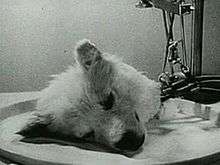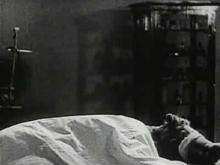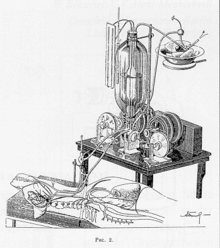Experiments in the Revival of Organisms
| Experiments in the Revival of Organisms | |
|---|---|
 Screenshot from the film showing the dog's head attached to Brukhonenko's autojektor | |
Release dates | 1940 |
Running time | 19:31 |
| Country | Soviet Union |
| Language |
Russian English |
| Budget | £20,000 |
Experiments in the Revival of Organisms (Russian: Эксперименты по оживлению организма) is a 1940 motion picture which documents Soviet research into the resuscitation of clinically dead organisms. It is available from the Prelinger Archives, and it is in the public domain. The British scientist J. B. S. Haldane appears in the film's introduction. The operations are credited to Doctor Sergei Brukhonenko and Boris Levinskovsky. The "autojektor" device demonstrated in the film is similar to modern ECMO machines, as well as the systems commonly used for renal dialysis in modern nephrology.
Synopsis

The film depicts and discusses, without going into much technical detail, a series of medical experiments. First, a heart (canine, as with all in this film) is shown being isolated from a body, with four tubes connected. Electricity has been applied to the organ, causing it to beat in the same way that it would have done in a living organism.
It then shows a lung in a tray, operated by bellows, oxygenating blood.
Following the lung scene we are shown the operation of a primitive heart-lung machine, the autojektor (or autojector), composed of a pair of diaphragm linear pumps and what appears to be an oxygen bubble chamber. We then see it is supplying a canine head with oxygenated blood. The head is shown to respond to external stimuli, but the film does not show the arterial and venous connections to the head.
Finally, a dog is brought to clinical death (depicted mostly via a graphical plot of lung and heart activity) by draining all blood from it, left for ten minutes, then connected to the autojektor described earlier, which gradually returns the blood into the animal's circulation. After several minutes, the heart fibrillates, then restarts a normal rhythm. Respiration likewise resumes and the machine is removed. Over the ensuing ten days, the dog recovers from the procedure and continues living a healthy life.
Reaction

Since its Prelinger Archives release, the film has provoked a lot of controversy, a large part being over whether or not the film is real. For example, at one point, the dog turns his head, which would be impossible if the head was cut where the video claims it was.[1]
Brukhonenko's decapitation experiment was remarked upon by George Bernard Shaw.[2]
Brukhonenko developed a new version of the autojektor (for use on humans) in the same year; it can be seen today on display at the Museum of Cardiovascular Surgery at the Bakulev Scientific Center of Cardiovascular Surgery in Russia.[3] Brukhonenko was posthumously awarded the prestigious Lenin Prize.[4]
In popular culture
- In 2009, the band The Paper Chase used portions of the film in their video "What Should We Do with Your Body? (The Lightning)".[5]
- A portion of the plot of James Rollins' novel Bloodline is based on this experiment.
- The 1945 novel That Hideous Strength by C. S. Lewis makes reference to the experiments.
- Polish poet Wisława Szymborska references the experiment in her poem The Experiment circa 1967.[6]
- Metallica's video for their song All Nightmare Long is partially based on the video, and shows Soviet scientists reanimating a dead cat.
- In the video game Team Fortress 2 a cosmetic set for the Medic is called Canis Ex Machina in reference to the Soviet experiments in 1940.
See also
References
- Hill JD, Gibbon John H. Part I. The development of the first successful heart-lung machine. Ann Thorac Surg. 1982;34:337–341
- Fou AA, Gibbon John H. The first 20 years of the heart-lung machine. Tex Heart Inst J. 1997;24:1–8 MEDLINE
- Probert WR, Melrose DG. An early Russian heart-lung machine. Br Med J. 1960;1047–1048
- LeGallois JJC. Experiments on the principle of life. Philadelphia: M. Thomas; 1813
- Brown-Sequard E. Recherches experimentales sur les proprietes physiologiques et les usage du sang rouge et du sang noir et leurs principaux elements gazeus, l’oxygene et l’acide carbonique. J Physiolo de l’Homme (Paris) 1858;1:95–122, 353–67, 729–35
- Ludwig C, Schmidt A. Das Verhalten der Gase, welche mit dem Blut durch den reizbaren Saungethiermuskel stromen. Leipzig Berichte. 1868;20:12–72
- Von Schroder W. Uber die Bildungsstatte des Harnstotts. Arch Exp Path Pharm. 1882;15:364–367
- Von Frey M, Gruber M. Untersuchungen uber den Stoffwechsel isolierter Organe. Ein respirations-apparat fur isolierte organe. Virchow’s Arch Physiol. 1885;9:519–532
- Jacobj C. Ein Beitrag zur Technik der künstlichen Durchblutung überlebender Organe. Arch Exp Pathol Pharmacol. 1895;36:330–348
- Cooley DA. Development of the roller pump for use in the cardiopulmonary bypass circuit. Tex Heart Inst J. 1987;14:113–118
- Brukhoneko S. Circulation artificielle du sang dans l’organisme entrier d’un chien avec coeur exclu. J Physiol Path Gen. 1929;27:257–272
- Brukhonenko SS. Struggling for life. Tekhnika Molodezi. 1955;6:25–29
- Steppuhn O, Zeiss H, Brukhonenko S. Biochemische Untersuchungen über “Bayer 205.”. Arch Schiffs und Tropen Hygiene. 1923;27:206–210
- Steppuhn O, Zeiss H, Brukhonenko S. Biochemical study of the trypanocidal drug “Bayer 205.”. Trudi Nauchnogo Khimiko-Pharm Inst. 1923;3:49–52
- Brukhonenko S, Steppuhn O. Experimentelles zur anwendung von “Germanin” (Bayer 205) bei bluttransfusionen. Munchener Medizinische Wochenschrift. 1927;74:1316–1317
- Brukhonenko SS, Tchetchuline S. Experiences avec la tete isolee du chien. J Physiol Path Gen. 1929;27:31–45
- Brukhonenko SS, Tchechulin SI. Experiments on isolation of dog’s head. Trudi Nauchnogo Khimiko-Pharm Inst. 1928;20:7–43
- Brukhonenko SS. Artificial circulation of the whole body of a dog with arrested heart. Trudi Nauchnogo Khimiko-Pharm Inst. 1928;20:44–72
- Perez F. La survivance du systeme nerveux central dans des conditions artificielles. La Presse Medicale. 1929;37:183
- Shaw GB. Shaw will sich kopfen lassen, wenn …. Berliner Tageblatt. 1929;130:1
- Puchkov NB. Further studying of the anabiosis of the warm-blooded animals. Biol Zhurnal. 1933;2:206–213
- Alexi-Meskishvili VV, Potapov EV, Beyer EAK, Hetzer R. Nikolai Terebinski (a pioneer of the open valve operation). Ann Thorac Surg. 1998;66:1440–1443
- Terebinski N. Experimental stenosis of the atrioventricular valves of the heart and their repair. Khirurgia. 1938;12:36–43
- Brukhonenko SS. Artificial circulation. Moscow: Nauka; 1964
- Richardson RG. In: Scalpel and heart. New York: Charles Scribner’s Sons; 1979; p. 223
- ↑ http://www.thinkartificial.org/videos/the-severed-head-of-a-dog-kept-alive/
- ↑ "Sergej Sergejewitsch Brychonenko". Archived from the original on 2007-01-21. Retrieved 2010-12-14.
- ↑ "Museum of Cardiovascular Surgery". Archived from the original on 2006-02-08. Retrieved 2006-03-06.
- ↑ ЛАБОРАТОРИЯ ЭКСПЕРИМЕНТАЛЬНОЙ ПАТОЛОГИИ at the Wayback Machine (archived January 29, 2007). sklifos.ru (in Russian)
- ↑ ""What Should We Do With Your Body? (The Lightning)" video". YouTube.
- ↑ ""Wisława Szymborska III (The Experiment)" Poem".
External links
- Experiments in the Revival of Organisms at the Internet Movie Database
- Experiments in the Revival of Organisms is available for free download at the Internet Archive
- Time Magazine reports on the film's premiere
- The Autojektor on display at the Scientific Center of Cardiovascular Surgery (in Russian) (link defunct as of January 8, 2008)
- A medical paper on Brukhonenko's work (in Russian, requires PubMed access)
- Brukhonenko excerpt from "The Golden Book of Russia. The Year 2000"